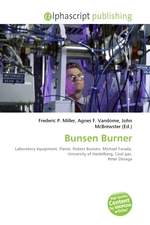Bunsen Burner
Frederic P. Miller, Agnes F. Vandome, John McBrewster
бумажная книга
High Quality Content by WIKIPEDIA articles! A Bunsen burner, named after Robert Bunsen, is a common piece of laboratory equipment that produces a single open gas flame, which is used for heating, sterilization, and combustion. When the University of Heidelberg hired Robert Bunsen in 1852, the authorities promised to build him a new laboratory building. Heidelberg had just begun to install coal-gas street lighting, so the new laboratory building was also supplied with illuminating gas. Illumination was one thing; a source of heat for chemical operations something quite different. Previous laboratory lamps left much to be desired regarding economy and simplicity, as well as the quality of the flame for a burner lamp, for it was desirable to maximize the temperature and minimize the luminosity. While his building was still under construction late in 1854, Bunsen suggested certain design principles to the university’s talented mechanic, Peter Desaga, and asked him to construct a prototype. (Similar principles had been used in an earlier burner design by Michael Faraday as well as in a device patented in 1856 by the gas engineer R W Elsner.)
Данное издание не является оригинальным. Книга печатается по технологии принт-он-деманд после получения заказа.


